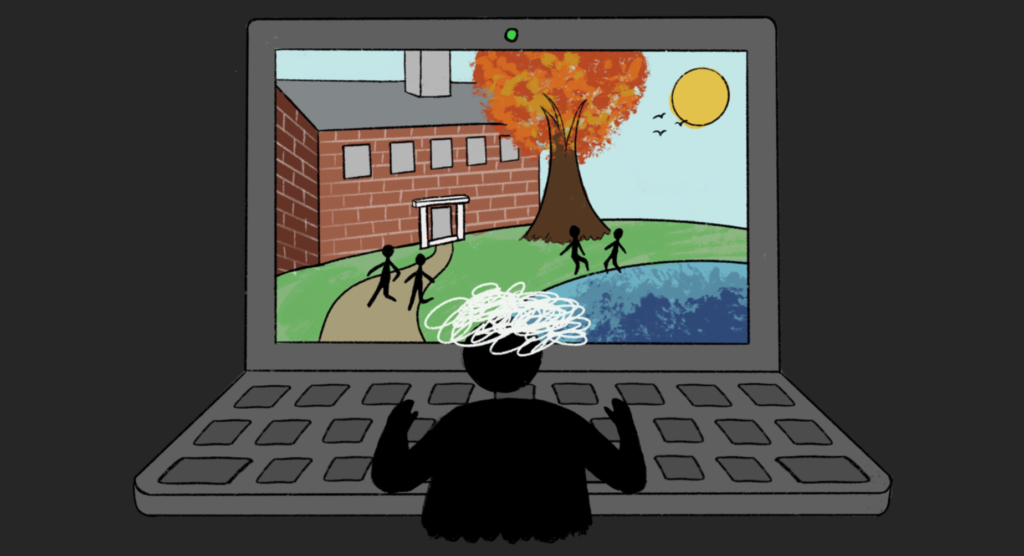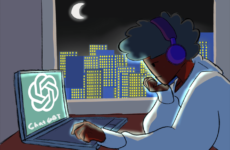
Graphic by Athena Liu/ The Choate News
A soft ringing from the alarm I’d set on my phone signaled the beginning of my first class of the week. It was Monday at 6:55 p.m., and I had just finished a delicious dinner of Panang curry and kai jiew (Thai-style omelets). After scrambling upstairs to my study, skipping every other step as I went, I flipped open my laptop and joined the Zoom room for my Science Research Program (SRP) class.
An unfamiliar sight appeared. Instead of the usual floating heads on my screen, I saw a classroom in the Science Center with all of my masked classmates sitting at their socially-distanced desks. “Hi, Praj!” they waved at me. I waved back with excitement and perplexion. Today was the first day students were allowed to attend in-person classes. Although I was the only student who attended class virtually, I still looked forward to reliving the sensation of learning in an actual classroom. The experience, however, was underwhelming.
A week after in-person classes resumed, our teacher tasked us with estimating the total number of outwardly-exposed bricks on the Science Center. Instead of roaming around outside in the fresh Wallingford air and talking with my classmates in real life, I was confined in my room, analyzing the building via Google Earth and discussing my ideas through the sluggish internet connection.
Because SRP takes up two consecutive blocks on Monday, we are allowed a ten-minute break after the first block. Instead of everyone turning off their cameras and muting themselves like we did during quarantine, my classmates walk out of the classroom together, chatting with each other as they stroll away. I am left alone in the silent classroom with my face still exposed on the Virtual Student display. Each Monday during the break, an aloof silence pervades my study. When I trudge downstairs to grab a snack, I wonder what my classmates are talking about outside in the hallway. What were they laughing about? Where were they walking? What conversations was I missing? Even though teachers are trying their best to make remote learners feel integrated into the community by finding accommodations more adept to a virtual setting, connecting with my class is still challenging. I do not want to admit it, but I feel left out.
On-campus students have many opportunities for interaction and collaboration: afternoon sports, SAC activities, dorm life. As a remote learner living on the other side of the world in Thailand, I encounter frequent issues in connecting with the Choate community — both in and out of class. Because of the difference in time zones, I’m not always available for collaboration and lose out on spending time with my peers. Because in-person interactions aren’t possible, it’s challenging to maintain my friendships and establish new ones.
However, a helpful remedy for this detachment is communication platforms such as Microsoft Teams and Discord, which allow me to converse with my friends, club members, dormmates, and teachers. Whenever I have free time, I use Discord to reach out to my friends to chat and play games online. With the popular games Among Us and Counter-Strike: Global Offense, I can continue to enjoy activities with my Choate friends despite the physical distance separating us.
The integration of Microsoft Teams to the Choate community allows me to continue interacting with club members and classmates when I have questions. Despite the lack of real-life interactions, these platforms help reestablish some degree of contact with the community, and I encourage other virtual students to take advantage of them.
This fall has been one of my toughest terms at Choate, especially mentally. The pandemic has posed many obstacles that prevent me from receiving the Choate experience I once knew. Nonetheless, I am still grateful for the many digital platforms that allow me to retain my relationships with the community and the effort that faculty continue to make to include remote learners into daily campus life. Virtual learning is obviously challenging, but finding connections with people on campus makes us all feel a little closer together — even in a world where we are anywhere from six feet to six thousand miles apart.




